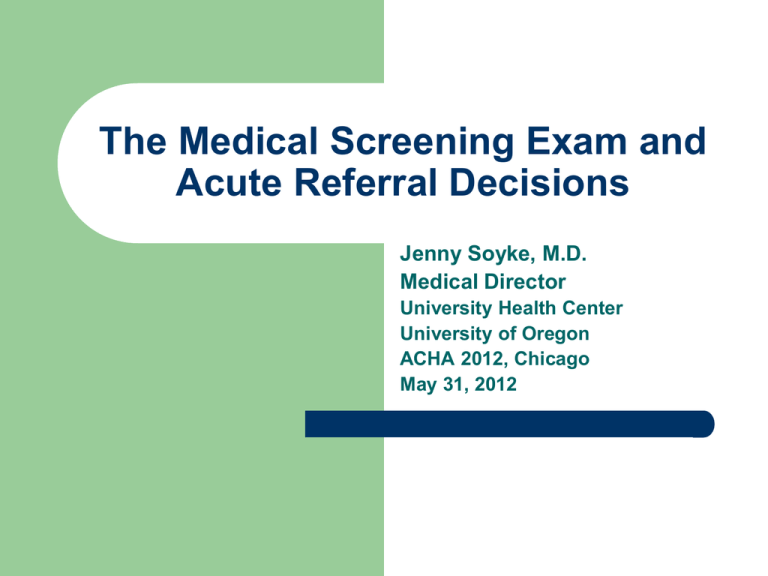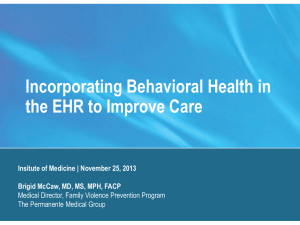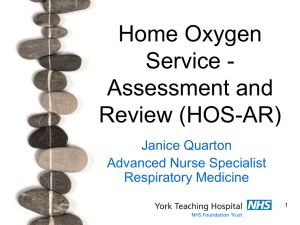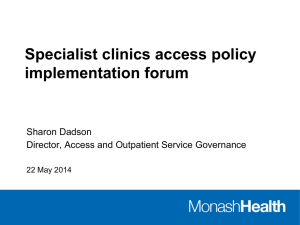presentation ( format)
advertisement

The Medical Screening Exam and Acute Referral Decisions Jenny Soyke, M.D. Medical Director University Health Center University of Oregon ACHA 2012, Chicago May 31, 2012 Bio – Jenny Soyke, M.D. B.A., University of Oregon M.D., Oregon Health Sciences University Family Medicine Residency, Madigan Army Medical Center (Tacoma, WA) American Board of Family Medicine, 1992 – present Board of Certification in Emergency Medicine, 19982008 Emergency Physician in practice 1996-2009 Medical Director at UO Health Center since 2009. I have no conflicts of interest to disclose.* Materials will be posted on ACHA website July 2 I will be posting both the full power point presentation and the handout on the ACHA website, where it will be available after July 2, 2012. The handout is simply a summary of the abstract, the topic relevance, the learning objectives, and the bibliography. Who are we? Physicians Nurse Practitioners Physician assistants Registered nurses Licensed or Credentialed Mental Health Professionals (Psychologists, LMFT, LCSW) Other? Medical Screening Exam The Medical Screening Exam is a concept which came out of the implementation of EMTALA (COBRA) laws governing transfer of patients between hospital emergency departments, in order to protect the health and safety of transferred patients. Acute referral decisions When students present to the college health center with acute injuries or illnesses which can’t be handled within either the scope of practice or the available clinic hours of the health center, what are the best steps to follow to ensure the student’s health and safety as we transfer these patients to the appropriate level of care? Is the MSE a knowledge gap in college health practice? College health centers outside of a medical school setting are typically ambulatory care centers with practical limitations in both scope of practice and clinic hours. What are the best methods to both ensure student safety and protect the reputation of your facility within your referral community as you make your referral decisions? EMTALA The Emergency Medical Treatment and Labor Act The 2003 regulations define a "dedicated emergency department" as a state-licensed ER or a place where medical services are provided on an urgent basis, without the need for an appointment, including (significantly) hospital-based ambulatory care centers. At a DED, any request for medical treatment triggers EMTALA obligations. This talk assumes context of non-EMTALA clinics. Avoid use of the term “urgent care” or “walk in for urgent care” if you are not an EMTALAcompliant organization. EMTALA is a law which advocates for patients. But you don’t want to be considered subject to the law if you are not required to be subject to the law, even though I’m going to urge you to honor the principles behind it. Context of College Health Though ambulatory care centers are not included in the EMTALA, the medical principles and medical ethics behind the medical screening exam are useful for application in college health. By using the patient care principles behind EMTALA, we provide our patients the highest level of medical care in acute referral decisions. **KEY CONCEPT** Exclusion Disclaimer If you share a campus with a medical school or other hospital, you almost certainly are subject to EMTALA. This talk is targeted to those health centers who are not subject to EMTALA. Why discuss EMTALA when the law doesn’t apply to us? “EMTALA compliance is, at base, a risk management endeavor.” (1) In analyzing transfer situations, good patient care decisions lead to better patient outcomes, leading to decreased institutional risk. Complicated discussions of actual situations and the competing interests at work are common to any acute referral situations, whether or not governed by EMTALA. Provisions of EMTALA “Any patient who "comes to the emergency department" requesting "examination or treatment for a medical condition" must be provided with "an appropriate medical screening examination" to determine if he is suffering from an "emergency medical condition". If he is, then the hospital is obligated to either provide him with treatment until he is stable or to transfer him to another hospital in conformance with the statute's directives.” (1) EMTALA Any patient who "comes to the emergency department" requesting "examination or treatment for a medical condition" College Health Any patient who comes to the student health center requesting "examination or treatment for a medical condition" EMTALA must be provided with "an appropriate medical screening examination" to determine if s/he is suffering from an "emergency medical condition". College Health will benefit from "an appropriate medical screening examination" to determine if s/he is suffering from a condition which we can appropriately treat with the health center resources at hand. EMTALA If he is, then the hospital is obligated to either provide him with treatment until he is stable or to transfer him to another hospital in conformance with the statute's directives. College Health If he is, we are obligated to either provide him with treatment until he is stable or to transfer him to an appropriate referral consultant or facility as a matter of responsible medical practice. EMTALA If the patient does not have an "emergency medical condition", the statute imposes no further obligation on the hospital. College Health If the patient does not have an "emergency medical condition", we still have an obligation to the student patient but have options to address her medical needs: Treating now Scheduling a subsequent appointment Referring elsewhere The acute referral decision When students present to the college health center with acute injuries or illnesses which can’t be handled within either the scope of practice or the available clinic hours of the health center, what are the best steps to follow to ensure the student’s health and safety as we transfer these patients to the appropriate level of care? Learning Objective #1 Identify the medical decision making necessary to determine whether a patient presenting to a student health center for an acute concern has a condition which can be appropriately addressed at the student health center. Content: Discussion of triage, resources for nurse triage, and the role of the physician or nurse practitioner in the medical screening exam. Learning Objective #2 Describe the essential components of the medical screening exam and how to apply the findings to decisions about evaluation, treatment and/or referral. Content: List of chief complaint-driven components of the medical screening exam for the most commonly-presenting acute injuries or illnesses in the college health setting. Learning Objective #3 Identify the medical decision making necessary to determine whether a patient with acute concerns can be appropriately evaluated and treated with the available resources and within the available time frame of the student health center. Content: List components of the above decision making related to the resources of the student health center, with recognition that SHS resources and hours vary widely. Learning objective #4 Discuss examples of acute medical problems likely to present to student health centers, and describe the components of the medical screening exam essential for evaluating disposition of each of these problems. Case discussions with group participation. Case discussions from the group During the talk, if a case occurs to you, write down the following: – – – – Major presenting symptom Major components of initial exam Complicating/competing social or other factors Your question or your insight Pass it to the aisle and I’ll do my best to choose some illustrative cases for discussion What are our staff resources? Physicians Nurse Practitioners, Physician assistants Registered nurses Licensed or Credentialed Mental Health Professionals (Psychologists, LMFT, LCSW) Ancillary services professionals: pharmacists, lab and X-ray technologists, etc. Where do we work? Med School health center with hospital (most likely subject to EMTALA) Large health center with inpatient/infirmary capacity Large health center with no inpatient capacity Small health center with full time physician(s) NP-staffed health centers RN-staffed health centers Learning Objective #1 Identify the medical decision making necessary to determine whether a patient presenting to a student health center for an acute concern has a condition which can be appropriately addressed at the student health center. Content: Discussion of triage, resources for nurse triage, and the role of the physician or nurse practitioner in the medical screening exam. What are the components which influence decision-making in acute referral situations? 1. 2. 3. 4. Available staff: consider their degrees, their background and their experience Available resources: time, space and materials (equipment, tools, meds, supplies and ancillary services) Condition of patient Student financial constraints can be considered but must not lead you away from appropriate referral decisions. All of these add up to determine treatment capacity as applied to the individual patient. What are your professional resources? University of Oregon Health Center - Eugene Primary Care – 12 FTE – Psychiatry – 3.4 FTE – 3 Psychiatrists (1.4 FTE) + 1 PMHNP + 1 QMHP Women’s Health – 1.0 FTE – 9 family physicians, 3 adult + 1 family nurse practitioners GYN 0.2 FTE + WHNP: 0.8 FTE Two FP physicians have extensive ED backgrounds. Two FP physicians are fellowship-trained sports medicine specialists. Eight R.N.s working in advanced roles (nsg staff 30) What are the components which influence decision-making in acute referral situations? 1. 2. 3. 4. Available staff: consider their degrees, their background and their experience Available resources: time, space and materials (equipment, tools, meds, supplies and ancillary services) Condition of patient Student financial constraints can be considered but must not lead you away from appropriate referral decisions. All of these add up to determine treatment capacity as applied to the individual patient. What are your facility resources? U of Oregon Health Center – Eugene, OR High complexity CLIA-certified laboratory X-ray with computerized radiography Pharmacy, full-service Equipment for IV tx, splinting, casting, procedures Dental Clinic with dentist and hygienists Physical Therapy and Sports Medicine Dietician and a certified diabetic educator What are the components which influence decision-making in acute referral situations? 1. 2. 3. 4. Available staff: consider their degrees, their background and their experience Available resources: time, space and materials (equipment, tools, meds, supplies and ancillary services) Condition of patient Competing interests All of these add up to determine treatment capacity as applied to the individual patient. What are the components which influence decision-making in acute referral situations? 1. 2. 3. 4. Available staff: consider their degrees, their background and their experience Available resources: time, space and materials (equipment, tools, meds, supplies and ancillary services) Condition of patient Competing interests All of these add up to determine treatment capacity as applied to the individual patient. Competing interests Student preference can go either way – – Financial concerns (hospital, ambulance) – Trust in health center and fear of the unknown Trust in community resources over health center Student financial constraints can be considered but must not lead you away from appropriate referral decisions. Available community resources What is your location? Eugene, Oregon Urban Extensive community medical resources Three emergency departments and hospitals; one is two blocks from campus Urgent Care (non-hospital-affiliated), also two blocks from campus Psychiatric ward in hospital close to campus What are the components which influence decision-making in acute referral situations? 1. 2. 3. 4. 5. Available staff Available resources Condition of patient Competing interests Student financial constraints can be considered but must not lead you away from appropriate referral decisions. All of these add up to determine treatment capacity as applied to the individual patient. Why do a medical screening exam? Avoid inappropriate referrals. Avoid having a patient deteriorate during a transfer because of a factor not identified prior to the transfer. Gain information in order to knowledgeably stabilize the patient Gain information for a knowledgeable discussion with the referral consultant Information to decide the appropriate referral direction. Why Do a Medical Screening Exam? Better and safer patient care Your health service will be treated with more respect from your referral resources which may result in better care for your students in the future Does the medical screening exam need to be done by a physician? EMTALA language specifies “qualified medical person” (1) as determined by the institution. However, EMTALA also says “any assessment which is done by any person other than a physician has a much higher risk of being found insufficient under EMTALA.” (1) This is risk management. Special qualifications matter: a WHNP or PMHNP may be more qualified than a specific physician for some particular acute referral situations, for example. Who is a Qualified Medical Person? RN-staffed health centers NP-staffed health centers Have a plan Know your resources Attempt to have the medical screening exams done by the clinicians with the most advanced knowledge or degree applicable to the situation. Triage Resources for nurse triage – – – Protocol books and courses Physicians and nurse practitioners on staff EXPERIENCE COUNTS When in doubt, consult. Who is the best person to make the needed decisions? – Consult laterally with another colleague or up– RN to NP, RN to physician, NP to physician, physician to physician. Learning Objective #2 Describe the essential components of the medical screening exam and how to apply the findings to decisions about evaluation, treatment and/or referral. Content: List of chief complaint-driven components of the medical screening exam for the most commonly-presenting acute injuries or illnesses in the college health setting. The Medical Screening Exam Focused history (focused HPI plus pertinent PMHx Vital signs Mental status Focused but thorough exam of affected body part – – – Uncover Undress Remove bandages A triage exam room is helpful Quick labs can be helpful in some cases (UHCG, UDIP) Why do a medical screening exam? Avoid inappropriate referrals. Avoid having a patient deteriorate during a transfer because of a factor not identified prior to the transfer. Gain information in order to knowledgeably stabilize the patient Gain information for a knowledgeable discussion with the referral consultant Information to decide the appropriate referral direction. The Ideal Medical Screening Exam Clearly identify and understand your capacities in advance. Recognize quickly if a student may need an acute referral – the longer it takes to recognize this, the more likely the patient will be dissatisfied by the process. Perform the medical screening exam and understand clearly why you need to transfer/refer. Be able to communicate your medical decision making to the patient and to your referral consultant. Stabilize the patient even if you can’t treat the patient definitively. (Dressing, splint, pain meds, etc) The Ideal Medical Screening Exam Clearly identify and understand your capacities in advance. Recognize quickly if a student may need an acute referral – the longer it takes to recognize this, the more likely the patient will be dissatisfied by the process. Perform the medical screening exam and understand clearly why you need to transfer/refer. Be able to communicate your medical decision making to the patient and to your referral consultant. Stabilize the patient even if you can’t treat the patient definitively. (Dressing, splint, pain meds, etc) The Ideal Medical Screening Exam Clearly identify and understand your capacities in advance. Recognize quickly if a student may need an acute referral – the longer it takes to recognize this, the more likely the patient will be dissatisfied by the process. Perform the medical screening exam and understand clearly why you need to transfer/refer. Be able to communicate your medical decision making to the patient and to your referral consultant. Stabilize the patient even if you can’t treat the patient definitively. (Dressing, splint, pain meds, etc) The Ideal Medical Screening Exam Clearly identify and understand your capacities in advance. Recognize quickly if a student may need an acute referral – the longer it takes to recognize this, the more likely the patient will be dissatisfied by the process. Perform the medical screening exam and understand clearly why you need to transfer/refer. Be able to communicate your medical decision making to the patient and to your referral consultant. Stabilize the patient even if you can’t treat the patient definitively. (Dressing, splint, pain meds, etc) The Ideal Medical Screening Exam Clearly identify and understand your capacities in advance. Recognize quickly if a student may need an acute referral – the longer it takes to recognize this, the more likely the patient will be dissatisfied by the process. Perform the medical screening exam and understand clearly why you need to transfer/refer. Be able to communicate your medical decision making to the patient and to your referral consultant. Stabilize the patient even if you can’t treat the patient definitively. (Dressing, splint, pain meds, etc) The Ideal Medical Screening Exam Clearly identify and understand your capacities in advance. Recognize quickly if a student may need an acute referral – the longer it takes to recognize this, the more likely the patient will be dissatisfied by the process. Perform the medical screening exam and understand clearly why you need to transfer/refer. Be able to communicate your medical decision making to the patient and to your referral consultant. Stabilize the patient even if you can’t treat the patient definitively. (Dressing, splint, pain meds, etc) Examples of most common conditions requiring acute referral from student health centers Lacerations Fracture/dislocations Head injury Abdominal pain Dehydration Severe infections Pain Psychiatric emergencies Lacerations Caveats about lacs – don’t make a decision until you’re sure of what you have – You don’t know what you have until you Remove the dressings entirely Cleanse and explore the wound (sometimes it’s bigger than you thought, sometimes it’s smaller than you thought). Assume likelihood of foreign body within the wound (big risk mgmt issue). If you decide to keep and treat the patient, be open to reversing course if, after you anesthetize, cleanse and irrigate the wound, you find that it’s deeper, dirtier or more complex than you feel comfortable treating. Each physician and NP knows her own limits on these. If you’re not adept with facial lacerations, nail bed or other hand lacs or complex layered repairs, it’s not in the best interests of either the patient or the institution for you to do it. Fracture/dislocation Adequate X-ray facility and professional clinician capable of reading X ray? Ability to properly splint with appropriate materials? Ability to safely reduce a dislocation? – – – Fingers, toes and patellae don’t typically require IV sedation State of medical science for shoulders is to perform these under IV sedation – decreases risk of nerve/tendon injury Nerve injury is a big concern and time is of the essence for hips, knees, ankles, elbows – call 911. “I think I dislocated my shoulder.” Dislocated shoulder AC joint separation Humeral head fracture Biceps tendon injury/rupture Shoulder sprain Clavicle fracture The medical screening exam is essential to make sure that you’re not sending a patient to the ED for a condition you can actually treat yourself. Traumatic Brain Injury – It’s a Bear….. Head injury Does the patient need a head CT? – See ACEP recommendations Do you have the capacity to order a head CT nearby and maintain responsibility for the patient? Would the patient be dischargeable if the head CT were negative? – See ACEP recommendations Head injury – ACEP recommendations “Which patients with mild TBI should have a noncontrast head CT scan in the ED? Level A recommendations (high degree of clinical certainty). A noncontrast head CT is indicated in head trauma patients with loss of consciousness or posttraumatic amnesia only if one or more of the following is present: headache, vomiting, age greater than 60 years, drug or alcohol intoxication, deficits in short-term memory, physical evidence of trauma above the clavicle, posttraumatic seizure, GCS score less than 15, focal neurologic deficit, or coagulopathy.” (5) Head injury – ACEP recommendations Level B recommendations (moderate clinical certainty). A noncontrast head CT should be considered in head trauma patients with no loss of consciousness or posttraumatic amnesia if there is a focal neurologic deficit, vomiting, severe headache, age 65 years or greater, physical signs of a basilar skull fracture, GCS score less than 15, coagulopathy, or a dangerous mechanism of injury.* *Dangerous mechanism of injury includes ejection from a motor vehicle, a pedestrian struck, and a fall from a height of more than 3 feet or 5 stairs. (5) Definition of mild TBI - ACRM “The American Congress of Rehabilitation Medicine delineated inclusion criteria for a diagnosis of mild TBI, of which at least 1 of the following must be met: 1. Any period of loss of consciousness of less than 30 minutes and GCS score of 13 to 15 after this period of loss of consciousness; 2. Any loss of memory of the event immediately before or after the accident, with posttraumatic amnesia of less than 24 hours; or 3. Any alteration in mental state at the time of the accident (eg, feeling dazed, disoriented, or confused).” (5) Definition of TBI - CDC “The Centers for Disease Control and Prevention has developed a similar conceptual definition for mild TBI (traumatic brain injury): Occurrence of injury to the head, resulting from blunt trauma or acceleration or deceleration forces, with one or more of the following conditions attributable to the head injury during the surveillance period: ● Any period of observed or self-reported transient confusion, disorientation, or impaired consciousness ● Any period of observed or self-reported dysfunction of memory (amnesia) around the time of injury ● Observed signs of other neurologic or neuropsychological dysfunction ● Any period of observed or self-reported loss of consciousness lasting 30 minutes or less.” (5) Deciding if the head injury patient is stable for outpatient evaluation - MSE HPI: was there LOC? Is there amnesia? Mental status and Neuro Exam Vital signs Social situation Extenuating circumstances (substances, other trauma or injuries, vomiting, etc) See ACEP recommendations for head CT See ACEP recommendations for discharge Head injury evaluation and acute referral decisions Does the patient meet the definition of TBI? Does the patient need a head CT based on ACEP criteria? Would the patient be safe to be discharged after a negative noncontrast CT? (see ACEP recommendation on this question, next slide) – If not, transfer rather than do outpatient CT. Is the patient stable and safe to travel to an outpatient CT and have you follow up the results? Is there time left in the day for this to occur? Would the patient be better served by getting the CT done in an E.D. setting? Does the patient need an ambulance? (significantly altered mental status, unstable vital signs, unreliability of other transport) Can the patient be safely discharged if CT is negative? From ACEP recommendations “Can a patient with an isolated mild TBI and a normal neurologic evaluation result be safely discharged from the ED if a noncontrast head CT scan shows no evidence of intracranial injury? Level A recommendations. None specified. Level B recommendations. Patients with an isolated mild TBI who have a negative head CT scan result are at minimal risk for developing an intracranial lesion and therefore may be safely discharged from the ED.* Therefore, these pts might be safe for an outpt CT followed up by you.* (JMS) * Next slide Can the patient be safely discharged if CT is negative? There are inadequate data to include patients with a bleeding disorder; who are receiving anticoagulation therapy or antiplatelet therapy; or who have had a previous neurosurgical procedure in this population.” (5) (Therefore, these patients must go to the ED in the first place. (JMS) Abdominal Pain What’s most common in college health? Appendicitis – see ACEP recommendations (3) Urinary Tract Infection including Pyelonephritis PID – pelvic inflammation secondary to STI ECTOPIC PREGNANCY always do a pregnancy test always do a pregnancy test always do a pregnancy test pregnancy test! Abdominal Pain Risk Management in the Evaluation of Abdominal Pain 1. Do not restrict the differential diagnosis solely by the location of the pain. 2. Do not use the presence or absence of a fever to distinguish surgical from medical etiologies of abdominal pain. 3. Do not assign a specific diagnosis which is unsupported by history, physical, or laboratory findings. 4. If you allow the patient to go home with close follow-up with you, be sure to give written discharge instructions which includes a specific follow up appointment and a list of reasons for which the student should go to the emergency department in the interim. Options in evaluating abdominal pain 1. Use serial evaluations over several hours to improve the diagnostic accuracy in patients with unclear causes of abdominal pain. 2. Collect a complete data set before reaching a differential diagnosis; consider a systemic data collection tool, such as a formatted chart. 3. Perform a stool for occult blood test in patients with abdominal pain. 4. Perform a pelvic examination in female patients with abdominal pain. 5. Always do a pregnancy test in biologic females. Signs and symptoms in abdominal pain – when it’s obvious Rebound tenderness – helpful when present, but can’t be used to rule out a significant diagnosis – Do not depend on the presence of rebound tenderness to make your referral decision. Diaphoresis Pallor Significant hypotension Significant hematemesis or melena Rigidity Signs and symptoms in abdominal pain – when it’s NOT obvious Patient is in a lot of emotional stress about the pain but the belly is entirely soft and the pain not well-localized. – – – Treat the pain Gather information Serial exams Labs normal or equivocal – not helpful There is no algorithm – just caveats Abdominal Pain + Pregnancy Abdominal pain + positive pregnancy test requires you to evaluate the patient for ectopic pregnancy. Don’t think too hard about this – just do it. Any reasons you can think of not to do these tests are going to sound foolish when you miss an ectopic pregnancy. Pelvic ultrasound, quantitative HCG, CBC or hemogram, +/- Rh factor Acute referral decisions in abd pain Vital sign stability? – Physical exam – Fever, tachycardia, hypotension? Rebound, rigidity Stoicism? Increase your index of suspicion/concern in favor of referral Cultural or language barriers – be careful – Practical and social considerations - abdominal pain Can serial exams be done within the health center over a period of multiple hours? Will the patient have easy access to follow up in the ER during the evening or weekend if he/she fails to improve? Can you get CBC and UA back in a timely manner at your H.C.? Does the patient require pain medication which you can’t provide? Medical Screening Exam in abdominal pain The previous discussion assumes you have time for a complete evaluation. What if the patient walks in 20 minutes before closing time? Minimum needed for MSE: – Focused history of present illness – Pertinent PMHx: Hx surgery, pregnancy, DM, IBS? – Focused exam (appropriately uncovered/undressed) – Referral decision vs. return appointment for next AM Script for late in day referral It doesn’t serve the patient well to do a too-rapid, incomplete abdominal pain evaluation. Don’t be rushed to make a decision if you truly feel you need more time with the patient for a safe decision. “We need a few hours to do serial exams and get the complete work-up that you need, and it’s not possible at this time of day. For your health and safety, my opinion is that you need to go to …..” Dehydration – referral decisions Available staff, resources, time and space need to be weighed as a whole. Even without capacity for IVF, a young healthy patient can be supported with antiemetics and watched through oral rehydration for a whole day if you have the time and space. How long since last urination (was it yesterday?) Symptomatic hypotension, symptomatic tachycardia, and altered mental status – if you don’t have capacity for fast high-volume IVF, expedite referral. Infection – considerations in referral decisions Peritonsillar cellulitis or abscess – – Is nonsurgical treatment with IV antibiotics and oral steroids community standard in your community? That depends on your ENT consultant. CALL ENT for their opinion. Is the airway threatened? Cellulitis of face or extremity True meningeal signs – time is of the essence - 911 Pneumonia – in the absence of asthma or other complications, can frequently be treated as outpatient if the patient is not hypoxic. Kidney infection – with outpatient IV antibiotics and IVF, in the absence of pregnancy, hospitalization not always required. Infection – considerations in referral decisions Peritonsillar cellulitis or abscess – Is nonsurgical treatment with IV antibiotics and oral steroids community standard in your community? That depends on your ENT consultant. CALL ENT for their opinion. – Is the airway threatened? Cellulitis of face or extremity True meningeal signs – time is of the essence - 911 Pneumonia – in the absence of asthma or other complications, can frequently be treated as outpatient if the patient is not hypoxic. Kidney infection – with outpatient IV antibiotics and IVF, in the absence of pregnancy, hospitalization not always required. Pain - Uncontrolled pain is a medical emergency However, knowing the source of the pain is equally as important as the existence of pain in your decision-making about acute referral. Is the source of the pain a potentially unstable condition? – – – Abdominal pain Severe headache Trauma Pain – is it acute or chronic? Uncontrolled pain is a medical emergency, however if the patient has chronic back pain or chronic headaches, less likely to need acute referral. For acute pain associated with a condition you are able to treat (infection, muscle pain, minor injury, UTI, etc) be sure to treat the pain along with the condition. Treating pain in the health center Many students haven’t started with the most basic self-treatment of acetaminophen or NSAID prior to presenting for care, so that can be a good place to start. IM or IV ketorolac (don’t give for potential surgical cases) IM or p.o. opiates Treating the underlying condition (injury or infection, for example) which is causing the pain Non-pharmaceutical alternatives are more difficult to schedule on an acute basis (massage and other alternative modalities) Psychiatric Emergencies Is patient a danger to self or others? – Our definition of safety for our students is probably more conservative than the definition of safety for an independent adult psych patient seen in the E.D.) Is there an acute underlying medical condition or substance intoxication? What are your resources to assist you in evaluating the patient? What social resources can be identified for the support of the student (family, dorm mates, R.A., etc). What psychological or psychiatric follow-up can be arranged in addition to primary care follow-up? Is lab testing necessary in the MSE of acute psychiatric patients? (ACEP) “What testing is necessary in order to determine medical stability in alert, cooperative patients with normal vital signs, a noncontributory history and physical examination, and psychiatric symptoms? Level B recommendations. In adult ED patients with primary psychiatric complaints, diagnostic evaluation should be directed by the history and physical examination. Routine laboratory testing of all patients is of very low yield and need not be performed as part of the ED assessment.” (4) Learning Objective #3 Identify the medical decision making necessary to determine whether a patient with acute concerns can be appropriately evaluated and treated with the available resources and within the available time frame of the student health center. List components of the above decision making related to the resources of the student health center, with recognition that SHS resources and hours vary widely. What component of the MSE would result in an immediate acute referral? Focus on those components which would result in an immediate decision. Examples: Head injury – altered mental status Significant hypoxia with fever Hypoxia with chest pain and SOB Unstable vital signs Orthostatic hypotension if no capacity for IV You can apologize for your limits, but don’t be embarrassed by them. Don’t feel pressured to treat a patient or perform a procedure which is clearly outside your scope of practice. Everybody has something that they don’t know. Know yourself, know your limits, and keep educating yourself to appropriately expand them It is not in the best interests of the patient, the institution or the clinician to risk a poor outcome when you feel you’re out of your depth. Know your capacities and resources. Have a plan for decision-making. These decisions are sometimes easy, but frequently are complex with competing interests to consider. Don’t skimp on the medical screening exam – make sure you have the information you need. Communicate clearly with the student and with your referral consultants about your assessment. The role of time and timing – particularly end of the day decisions It’s not only about your convenience – it’s also about safety. Can you safely and completely evaluate the patient in the time available? Don’t be tempted to cut corners because an abdominal pain pt walked in at 4:30 PM. Consider convenience to other patients. What happens to the other patients needing care if it will take you an hour to repair complicated lacerations? What is the budget impact from overtime costs for nursing, x-ray, lab, pharmacy, etc? The role of timing A head injury or an abdominal pain patient is not the same at 9 AM and at 4 PM. Serial exams – important in many conditions– require a stretch of time. With the medical screening exam, decide what they need, then decide if you can provide it safely and completely in the time available. If not, arrange transfer. Scripts “I’m going to consult _____ because I’m concerned you may need to be transferred to the emergency department.” – It is wise not to present the transfer as a “done deal” because sometimes your consultant will recommend a perfectly acceptable treatment you can provide, then it’s difficult for the patient to change gears. “I want you to have the appropriate treatment for your condition.” Scripts “I am terribly sorry; we want to take care of you here, but my medical judgment is that you need treatment that we can’t provide here.” – Be specific about what the other facility can do for them that you can’t do. “This is what I would recommend if you were my own daughter/son.” “I am aware you’re concerned about money, but I’m very concerned about keeping you safe.” Components of a responsible transfer 1. 2. 3. 4. 5. 6. 7. Do the medical screening exam, and document it. Make a decision as quickly as possible Determine a safe transport method Get the patient’s permission Stabilize for transport Call consultant Send medical records Components of a responsible transfer 5. Stabilize for transport – depends on distance Control bleeding Splint/immobilize Relieve pain – use short-acting when possible for abdominal pain. 6. Call consultant Include discussion about stabilization treatment. 7. Send medical records Stat transcription or handwritten record of your evaluation and treatment. Include X rays and labs. Don’t delay transport but this is essential – fax if necessary. How to Make the Transfer Smooth Tell the patient you are going to consult to help make the decision. Be careful about telling the patient what will happen prior to speaking with the consultant – sometimes the consultant will have a different approach. Tips for consulting (next slide) Make a decision about appropriate transport. EMTALA rules re: transfers (FYI) Medical screening exam is required. Patient has been stabilized within the facility’s capacity. Patient has been counseled about the risks and benefits of transfer and advised that you believe the risks are outweighed by the benefit. Patient signs consent. Both the receiving consultant and the receiving facility have been contacted and have accepted the patient. Medical records are sent with the patient. All of the above is documented on a form that goes with the patient. Transport capacity is adequate for the patient’s condition. How to present the patient to a consultant for an acute referral. Be succinct – what were the key points in your decision-making? What is your diagnosis or Diff Dx? This is not a grand rounds presentation. Cut to the chase, then be ready with details when asked. Tell the consultant what you want to do, and what you need from them. Is it an opinion, an acceptance of transfer, and/or advice about stabilization treatment prior to transfer? Be clear. Consulting for transfer – early pregnancy and pain “I have a 22 year old woman with a positive pregnancy test and acute significant LLQ pain. I’m concerned about ectopic pregnancy and I’m arranging transport to the E.D.” – Be prepared to answer questions about abdominal exam, orthostatic stability, bleeding, last meal, Gravida Para and Rh status. Consulting for transfer – shoulder dislocation “I have a 30 year old male with a right dislocated shoulder by exam, and I’m sending him over to you immediately by private car. We are not going to manipulate it here without adequate anesthesia.” – Be prepared to answer questions about time of injury and neurovascular exam. Consulting for transfer – possible DVT “I have a 40 year old male/female with a swollen right leg, shortness of breath and hypoxia with an O2 sat of 88%. I’m concerned about pulmonary embolism from DVT, and I’m sending him/her without labs, coming to you by ambulance. – – Be prepared to answer questions about risk factors, onset of symptoms, and medical history. Why are the labs or X ray not part of this patient’s medical screening exam? Consulting for hypoxia “I have a 28 year old woman with lupus who presented today with shortness of breath and an O2 sat of 85%. She comes up to 92% on O2. She is not anticoagulated.” – – Be prepared with medical history and exam findings. This is a case of sending a patient with a differential diagnosis instead of a diagnosis, as there are multiple possible diagnoses here, but the patient’s condition warrants immediate transfer because of the seriousness of the differential diagnoses. The Medical Screening Exam is essential You do not have the information you need to appropriately transfer the patient unless you examine them. In order to make an acute referral, you need either a diagnosis or a differential diagnosis based on a competent medical screening exam. – – – – Focused, pertinent HPI and pertinent PMHx Vital signs, mental status Focused exam – uncover, undress, remove bandages Quick labs such as UHCG or UDIP can be helpful Social and Practical Considerations We want to take care of our students ourselves, but sometimes that’s not the best medical care for them. Reputation: we want to handle these cases in ways that give the students confidence in our work and in a way that makes our professional colleagues respect our work. We cannot allow concerns about financial stresses to the uninsured or underinsured student unduly influence our medical decision-making. Making the wrong decision for these reasons won’t help the patient and won’t stand up in court. Should you charge for the medical screening exam? It depends on your system. There is a charge for the medical screening exam in the E.D. Was treatment initiated – did the student receive services? The medical screening exam is a service in itself, however students can feel very frustrated if they are charged for being told they need to go elsewhere for care. But you have provided a service. Learning objective #4 Discuss examples of acute medical problems likely to present to student health centers, and describe the components of the medical screening exam essential for evaluating disposition of each of these problems. Case discussions with group participation. Summary The medical screening exam is a concept which is part of EMTALA, to ensure that patient transfer decisions are made with adequate information and communication to ensure patient safety. Though student health centers aren’t typically subject to EMTALA, the concepts behind the law can serve as an example to guide us in evaluating patients and making safe transfer decisions and arrangements. Why do a medical screening exam? Avoid inappropriate referrals. Avoid having a patient deteriorate during a transfer because of a factor not identified prior to the transfer. Gain information in order to knowledgeably stabilize the patient Gain information for a knowledgeable discussion with the referral consultant Information to decide the appropriate referral direction. The Medical Screening Exam is essential You do not have the information you need to appropriately transfer the patient unless you examine them. In order to make an acute referral, you need either a diagnosis or a differential diagnosis based on a competent medical screening exam. – – – – Focused, pertinent HPI and pertinent PMHx Vital signs, mental status Focused exam – uncover, undress, remove bandages Quick labs such as UHCG or UDIP can be helpful Sample Cases Audience participation Sample cases Medical Screening Exam and Acute Referral Decisions in the Context of College Health Centers - Bibliography 1. Emtala.com. Frequently Asked Questions about the Emergency Medical Treatment and Active Labor Act (EMTALA). http://www.emtala.com/index.html 2. American College of Emergency Physicians Clinical Policies http://www.acep.org/clinicalpolicies/ 3. American College of Emergency Physicians, Clinical Policy: Critical Issues in the Evaluation and Management of Emergency Department Patients with Suspected Appendicitis. Annals of Emergency Medicine.2010; 55:71-116 4. American College of Emergency Physicians, Clinical Policy: Critical Issues in the Diagnosis and Management of the Adult Psychiatric Patient in the Emergency Department. Annals of Emergency Medicine.2006; 47(1):79-99. 5. American College of Emergency Physicians Clinical Policy: Neuroimaging and Decisionmaking in Adult Mild Traumatic Brain Injury in the Acute Setting. Annals of Emergency Medicine.2008; 52(6):714-748. Additional Resources Shaider, Jeffrey J., et al (Editors), Rosen and Barkin's 5-Minute Emergency Medicine Consult, Fifth Edition, 2010. Tintinalli, Judith, et al; Tintinalli's Emergency Medicine: A Comprehensive Study Guide, Seventh Edition, 2010 Briggs, Julie K. Telephone Triage Protocols for Nurses, Third Edition, 2007 Contact information Jenny Soyke, M.D., University Health Center 1232 University of Oregon, Eugene, Oregon 97403-1232 jsoyke@uoregon.edu






